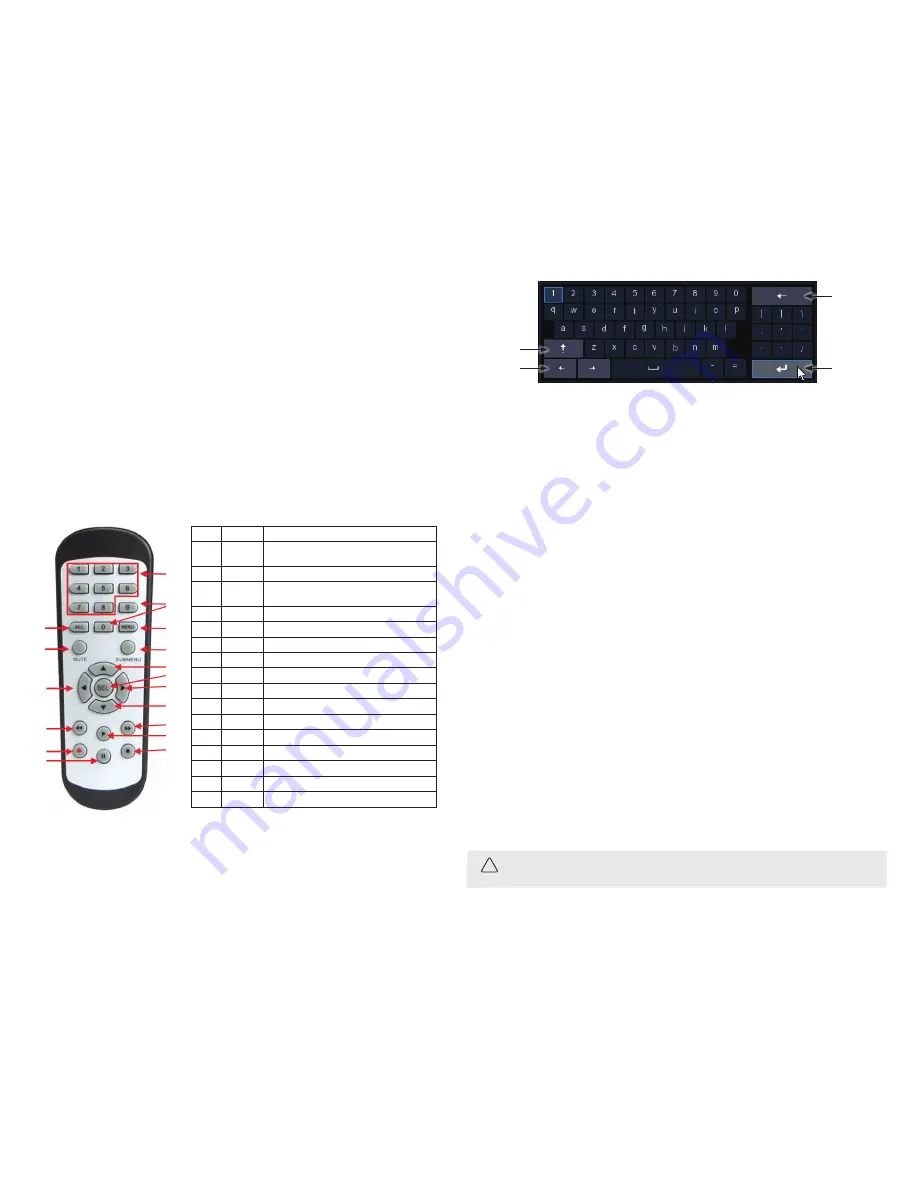
2
www.Observint.com
© 2018 Observint Technologies, Inc. All rights reserved.
Move cursor
left, right
Enter
Click to
delete
previous
character
Click for
upper,
lower case
Installing the System
Step 1. Getting Started: Unpacking the Equipment
What’s in the box
Your system includes:
•
DVR
•
USB mouse
•
Power adapter for DVR
•
Remote control
Remove the equipment from its packaging and place it on a flat, clean surface. Inspect each item. If any visible damage is present, contact
your supplier for a replacement. Verify that your order is complete.
What you need
Although each security system installation is different, most require the following items not included with your system components:
•
Cameras and cables compatible with the DVR. The
VIDEO INPUT
connectors on the back panel support analog cameras. Check the
Specifications
section of this guide for more information.
•
IP cameras installed on the Ethernet network (LAN) associated with the DVR must be compatible. Check the
Specifications
section of
this guide for more information.
•
Tools to install the cameras and route power and video cables
•
Fasteners to attach the cameras to the mounting surfaces, calking
•
VGA or HDMI compatible computer monitor to connect to the DVR.
•
Un-interuptable power supply (UPS) is recommended. This UPS is used to ensure system stability during voltage surges, sags, and
outages. If a UPS is not available, a power strip with strong surge protection is highly recommended.
Step 2. Install the DVR
HDD Installation
If your DVR was purchased without an HDD, or you want to add an additional HDD or replace one, follow the guidelines shown here. The HDD
installation should be performed before using your DVR. For lasting performance and reliability, install only security grade HDDs in your DVR.
The chassis is designed to accommodate both 3.5 inch and 2.5 inch HDDs, with an HDD capacity up to 8 TB.
CAUTION
Before performing this procedure, ensure that the power cord is not disconnected from the DVR.
Using the mouse
1.
Left Button:
—
Click to select menu options.
—
During live viewing in split-screen view, double-click on a channel to view it in full-screen. Double-click the channel again to
return to split-screen viewing.
—
Click upon a channel on
Live Viewing
screen to open
Camera Quick Toolbar
.
—
Click and hold to drag sliders and scales on menu mode
2.
Right Button:
—
Click once to open the task bar on the Live Viewing screen.
—
In menus, click to go back or close the menu.
3.
Scroll Wheel:
—
In menus, scroll to move up / down through the menu content.
—
While hovering over the volume control wheel, scroll to turn system volume up / down.
Using the Remote Control
3
5
11
14
16
9
1
6
4
2
10
13
15
12
7
8
9
No.
Icon
Description
1
1-8
Numeric keys
Press to display channel 1~8
2
9, 0
Numeric keys
3
ALL
Press to display all channels
Multiple display mode
4
Menu
Press to enter or exit the Main Menu
5
Mute
Mute On/off
6
Submenu
Go to submenu
7
Up arrow key; Volume increase
8
SEL
Press to enter the selected menu item and edit the setting
9
Left/Right key; Decrease/increase parameter value of control bar.
10
Down arrow key; Volume decrease
11
Press to rewind during video playback
12
Press to fast forward during video playback
13
Press to play recorded video or enter the recording search menu
14
Press to start manual recording
15
Press to stop manual recording or stop the video playback
16
| |
Press to pause the video playback or enter frame-playback mode
Using the Virtual Keyboard
When you click in an editable data entry field, a virtual keyboard will appear. Click on the character in the keyboard to enter it into the field.
When the data entry is complete, click the
Enter
key in the lower right corner.



























